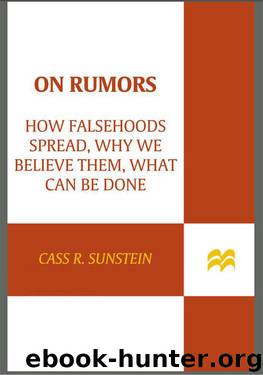On Rumors: How Falsehoods Spread, Why We Believe Them, What Can Be Done by Sunstein Cass R

Author:Sunstein, Cass R. [Sunstein, Cass R.]
Language: eng
Format: epub
Publisher: Farrar, Straus and Giroux
Published: 2010-04-01T04:00:00+00:00
On Prior Convictions and Trust
How can these findings be explained? When will balanced information actually help? When do corrections work?
We have seen that when people process information, they are affected by their emotions and their prejudices. After purchasing a new car, people seek out more information about that very car. Having chosen a Toyota Camry Hybrid, they want to read more about that particular vehicle. The most obvious explanation is not that they want to learn more about the car they have already bought. It is that they seek reassurance that they made the right decision.
Biased assimilation is partly produced by our desire to reduce cognitive dissonance.63 We seek out and believe information that we find pleasant to learn, and we avoid and dismiss information that we find disturbing. Some rumors are fun; others are not exactly that, but they are exciting, perhaps a bit thrilling, and people enjoy believing them. Even when rumors produce outrage, people can engage them for that reason; when people are generally angry, it can be comforting and even fun, in a sense, to think that there are particular grounds for outrage. Other rumors are disturbing, even a bit frightening, and people want to think that they are false.
The studies involving capital punishment and same-sex relations are best understood in this light. When people display biased assimilation, motivational factors are usually at work. If people are motivated to credit arguments that fit with what they already think and to discredit arguments that do not, the findings of the studies are not so surprising. Consider in this light what social scientists call disconfirmation bias—people’s tendency to work especially hard to disprove arguments that contradict their original beliefs. If our judgments are motivated, then it is easy to see why balanced information might serve only to entrench our original beliefs.
But this is just part of the story. To see what is missing, suppose that society consists of two groups of people, the sensibles and the unreasonables, and that members of both groups have strong prior beliefs. Suppose that the sensibles have a strong commitment to certain views—say, that the Holocaust actually happened, that al-Qaeda was responsible for the attacks of 9/11, that the president is not a communist spy. Suppose that the sensibles read balanced materials on these three questions.
To the sensibles, the materials that support their original view will seem more than just convincing; those materials will also offer a range of details that, for most sensibles, will fortify what they thought before. By contrast, the materials that contradict their original views will seem implausible, incoherent, ill-motivated, and probably a bit crazy. The result is that the original convictions of the sensibles will be strengthened. They have learned something new in support of those convictions, and they have found nothing at all that undermines them.
Of course the opposite pattern will be observed for the unreasonables, who begin with the belief that the Holocaust did not happen, that the United States was itself responsible for the attacks on 9/11, that the president is a communist spy.
Download
This site does not store any files on its server. We only index and link to content provided by other sites. Please contact the content providers to delete copyright contents if any and email us, we'll remove relevant links or contents immediately.
Rewire Your Anxious Brain by Catherine M. Pittman(17581)
Talking to Strangers by Malcolm Gladwell(11865)
The Art of Thinking Clearly by Rolf Dobelli(8836)
Mindhunter: Inside the FBI's Elite Serial Crime Unit by John E. Douglas & Mark Olshaker(7830)
Becoming Supernatural by Dr. Joe Dispenza(7100)
Change Your Questions, Change Your Life by Marilee Adams(6637)
Nudge - Improving Decisions about Health, Wealth, and Happiness by Thaler Sunstein(6629)
The Road Less Traveled by M. Scott Peck(6627)
The Lost Art of Listening by Michael P. Nichols(6465)
Enlightenment Now: The Case for Reason, Science, Humanism, and Progress by Steven Pinker(6404)
Win Bigly by Scott Adams(6306)
Mastermind: How to Think Like Sherlock Holmes by Maria Konnikova(6227)
The Way of Zen by Alan W. Watts(5790)
Daring Greatly by Brene Brown(5636)
Grit by Angela Duckworth(4729)
Big Magic: Creative Living Beyond Fear by Elizabeth Gilbert(4719)
Men In Love by Nancy Friday(4315)
Flow by Mihaly Csikszentmihalyi(4047)
The Four Tendencies by Gretchen Rubin(4018)
